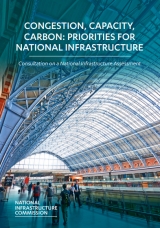Interim National Infrastructure Assessment, Congestion, Capacity, Carbon
On 5 October 2015, the then-Chancellor George Osborne announced the creation of a National Infrastructure Commission (NIC) to provide an unbiased analysis of the UK's long-term infrastructure needs, delivering a long-term assessment and plan early in each parliament.
It is intended to report every five years, looking 30 years ahead and to examine the evidence across sectors including; energy, roads, rail transport, ports and airports, water supply, waste, flood defences, digital and broadband, and how investment could support housing development.
On 13 October 2013, the NIC published an interim National Infrastructure Assessment, Congestion, Capacity, Carbon: Priorities for national infrastructure. Consultation on a National Infrastructure Assessment, examining seven key areas, and setting out the vision and priorities for helping meet the country’s needs up to 2050:
- Building a digital society.
- Connected, liveable city-regions.
- Infrastructure to support housing.
- Eliminating carbon emissions from energy and waste.
- A revolution in road transport.
- Reducing the risk of drought and flooding.
- Financing and funding infrastructure in efficient ways.
The interim assessment identifies key priorities for consideration and consultation in preparation for the NIC's 2018 National Infrastructure Strategy.
Launching the interim assessment, NIC chairman Lord Adonis, warned that the UK faces gridlock on the roads, railways and in the skies, as well as slower mobile and broadband connections and ever-worsening air quality unless the government tackles congestion, capacity and carbon. He suggested that the most serious infrastructure failure of all was the inability to reach a firm decision on expanding Heathrow Airport ,13 years after the initial statement of policy.
Lord Adonis said; “We cannot afford to sit on our hands – Ministers must act now to tackle the Three Cs of congestion, capacity and carbon if we are to have infrastructure fit for the future, supporting economic growth across the country.”
He also warned that infrastructure is not just a job for Whitehall, urging local leaders to develop their own plans to meet the needs of their communities.
The deadline for responses to the interim assessment consultation was 12 January 2018.
[edit] Related articles on Designing Buildings Wiki
- Building our Industrial Strategy: green paper.
- Construction 2025.
- Osborne launches National Infrastructure Commission.
- Government construction strategy.
- Infrastructure and Projects Authority.
- Infrastructure UK.
- National Infrastructure Commission NIC.
- National Infrastructure Commission’s Annual Monitoring Report 2020.
- National Infrastructure Plan.
- National Infrastructure Pipeline.
- National Infrastructure Plan for Skills.
- National Needs Assessment NNA.
- Will government waste the opportunity of the National Infrastructure Assessment?
Featured articles and news
Delivering for tenants; National Retrofit Hub
New report offers recommendations to strengthen energy efficiency standards to protect private renters.
Government consultations for the summer of 2025
A year of Labour, past and present consultations on the environment, the built environment, training and tax.
CMA competitiveness probe of major housing developers
100 million affordable housing contributions committed with further consultation published.
Homes England supports Greencore Homes
42 new build affordable sustainable homes in Oxfordshire.
Zero carbon social housing: unlocking brownfield potential
Seven ZEDpod strategies for brownfield housing success.
CIOB report; a blueprint for SDGs and the built environment
Pairing the Sustainable Development Goals with projects.
Types, tests, standards and fires relating to external cladding
Brief descriptions with an extensive list of fires for review.
Latest Build UK Building Safety Regime explainer published
Key elements in one short, now updated document.
UKGBC launch the UK Climate Resilience Roadmap
First guidance of its kind on direct climate impacts for the built environment and how it can adapt.
CLC Health, Safety and Wellbeing Strategy 2025
Launched by the Minister for Industry to look at fatalities on site, improving mental health and other issues.
One of the most impressive Victorian architects. Book review.
Common Assessment Standard now with building safety
New CAS update now includes mandatory building safety questions.
RTPI leader to become new CIOB Chief Executive Officer
Dr Victoria Hills MRTPI, FICE to take over after Caroline Gumble’s departure.
Social and affordable housing, a long term plan for delivery
The “Delivering a Decade of Renewal for Social and Affordable Housing” strategy sets out future path.
A change to adoptive architecture
Effects of global weather warming on architectural detailing, material choice and human interaction.
The proposed publicly owned and backed subsidiary of Homes England, to facilitate new homes.
How big is the problem and what can we do to mitigate the effects?
Overheating guidance and tools for building designers
A number of cool guides to help with the heat.
The UK's Modern Industrial Strategy: A 10 year plan
Previous consultation criticism, current key elements and general support with some persisting reservations.
Building Safety Regulator reforms
New roles, new staff and a new fast track service pave the way for a single construction regulator.


























